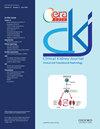The weighing process in patients on hemodialysis: an opportunity to improve volume management
IF 3.9
2区 医学
Q1 UROLOGY & NEPHROLOGY
引用次数: 0
Abstract
Introduction Hemodialysis relies on accurate body mass (BM) assessment to determine ultrafiltration volumes, but we have not identified published practice patterns, disclosing how to handle clothing mass. Here we investigated the potential impact of clothing mass on predialysis BM determination, hypothesizing that a standardized template for clothing mass estimation enhances accuracy, compared to conventional practice. Methods Measurements included dressed and undressed BM predialysis. A pre-established template for average clothing mass was used to approximate undressed BM from clothed measurements. Differences to undressed BM were compared using Bland-Altman plots and tested for statistical significance using Wilcoxon signed rank tests. Results After excluding erroneous results, data from 48 patients were analyzed. Thirty-six patients (75%) did not habitually estimate clothing mass, but used their dressed BM as the predialysis BM, while the other 12 patients (25%) reported deducting a self-estimated clothing mass from their clothed predialysis BM. The differences to undressed BM were 0.819 ± 0.462 kg and 0.342 ± 0.321 kg in these two groups, respectively, indicating that patients underestimated clothing mass. Using the template to deduct clothing mass from clothed predialysis BM, these differences could be reduced to 0.197 ± 0.220 kg and 0.133 ± 0.135 kg, respectively. The average differences using the patient-reported BM and the template-based BM made up 39.4% and 8.6% of the average, subsequent ultrafiltration volume, respectively, suggesting that potential overestimation of the actual ultrafiltration volume could be reduced. Conclusion A standardized template for clothing mass may be useful to derive representative predialysis BM, leading to more precise ultrafiltration calculation. Exact BM determination might improve volume management in hemodialysis.血液透析患者的称重过程:改善容量管理的契机
导言 血液透析依赖于准确的体重(BM)评估来确定超滤量,但我们尚未发现公开发表的实践模式,也未披露如何处理衣物质量。在此,我们研究了衣物质量对透析前体重测定的潜在影响,并假设与传统做法相比,标准化的衣物质量估算模板可提高准确性。方法 测量包括穿衣和脱衣透析前血压。使用预先确定的平均衣物质量模板,根据穿衣测量结果估算未穿衣时的血压。使用布兰-阿尔特曼图比较与未穿衣服时的血压差异,并使用 Wilcoxon 符号秩检验进行统计学意义检验。结果 在排除错误结果后,对 48 名患者的数据进行了分析。36名患者(75%)没有习惯性地估算衣物质量,而是将其穿衣后的血压作为透析前的血压,而另外12名患者(25%)则表示从其穿衣后的透析前血压中扣除了自我估算的衣物质量。这两组患者与脱衣体重的差值分别为 0.819 ± 0.462 kg 和 0.342 ± 0.321 kg,表明患者低估了衣物质量。使用模板从穿衣透析前血压中扣除衣物质量后,这些差异可分别降至 0.197 ± 0.220 kg 和 0.133 ± 0.135 kg。使用患者报告的血液质量和基于模板的血液质量的平均差异分别占后续平均超滤量的 39.4% 和 8.6%,这表明可以减少对实际超滤量的潜在高估。结论 服装质量的标准化模板可能有助于得出具有代表性的透析前血浆质量,从而更精确地计算超滤量。精确测定血容量可改善血液透析中的容量管理。
本文章由计算机程序翻译,如有差异,请以英文原文为准。
求助全文
约1分钟内获得全文
求助全文
来源期刊

Clinical Kidney Journal
Medicine-Transplantation
CiteScore
6.70
自引率
10.90%
发文量
242
审稿时长
8 weeks
期刊介绍:
About the Journal
Clinical Kidney Journal: Clinical and Translational Nephrology (ckj), an official journal of the ERA-EDTA (European Renal Association-European Dialysis and Transplant Association), is a fully open access, online only journal publishing bimonthly. The journal is an essential educational and training resource integrating clinical, translational and educational research into clinical practice. ckj aims to contribute to a translational research culture among nephrologists and kidney pathologists that helps close the gap between basic researchers and practicing clinicians and promote sorely needed innovation in the Nephrology field. All research articles in this journal have undergone peer review.
 求助内容:
求助内容: 应助结果提醒方式:
应助结果提醒方式:


